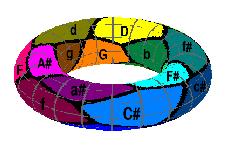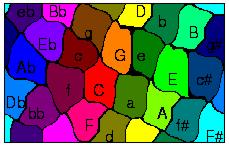Toroidal Models of Inter-Key Relations (ToMIR)
Benjamin Blankertz, Hendrik Purwins and Klaus Obermayer
[Abstract: gzipped
ps-file or pdf-file]
Emergance of ToMIR from psychoacoustic experiments and analysis of western tonal music


Benjamin Blankertz, Hendrik Purwins and Klaus Obermayer
[Abstract: gzipped
ps-file or pdf-file]
Emergance of ToMIR from psychoacoustic experiments and analysis of western tonal music


The torus on the left is a geometric representation of the inter-key relations of all major and minor keys, derived from psychoacoustic experiments by Krumhansl and Kessler [1] (shown in 3-dimensional representation). The torus on the right was derived solely from Alfred Cortot's recording of the Chopin preludes, op. 28 by the technique of constant Q profiles. (shown in 2-dimensional representation: identify left and right border and upper and lower border).
Deriving a ToMIR from basic harmonic relations

Strip of key, derived from Arnold Schoenberg's charts of key regions
[2]

First Step (The strip is shown somewhat strechted for better display)

Second step: Double appearences of minor keys are brought to accordance
The borders of the tube show keys that are enharmonically equal. These
are united by bending the tube and glewing together its ends. This gives
a toroid surface around which the circles of fifths for major and minor
keys wrap three times before joining themselves.
[1] C.L. Krumhansl and E.J. Kessler (1982),
Tracing the dynamic changes in perceived tonal organization in a spatial
representation of musical
keys, Psychological Review Vol. 89, No. 4, 334-368.
[2] A. Schoenberg (1969), Structural functions of harmony, 2. edition,
Norton, New York.
This material is part of a talk presented at
| mail to: <blanker@math.uni-muenster.de> | go to: dsp-page | go to: home-page |